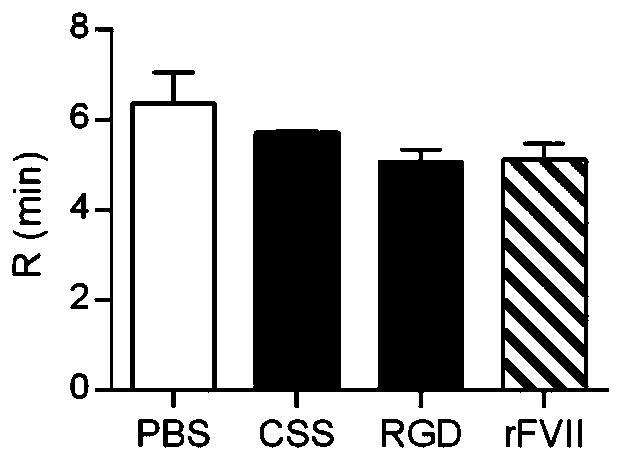css-peg-grgds nanoparticle and its preparation method and application in venous hemostasis
A nano-particle and vein technology, applied in the field of CSS-PEG-GRGDS nano-particles and its preparation, can solve the problems of difficult onset of internal bleeding, achieve the effect of improving self-rescue and mutual rescue capabilities, efficient hemostasis effect, and broad application prospects
- Summary
- Abstract
- Description
- Claims
- Application Information
AI Technical Summary
Problems solved by technology
Method used
Image
Examples
Embodiment 1
[0082] Embodiment 1, preparation CSS-PEG-GRGDS nanoparticle
[0083] Step 1: Synthesis of CSS
[0084] According to the following chemical equation, amino succinylation of chitosan is used to synthesize succinylated chitosan derivatives (CSS), and the specific synthesis method is:
[0085] 1g chitosan (M w =8~10k Da, n is 45~55) was dissolved in 20mL0.37% hydrochloric acid solution; 0.63g succinic anhydride (the molar ratio of chitosan and succinic anhydride was 1:63) was dissolved in 5mL pyridine, at room temperature , Dropped into the chitosan solution under vigorous stirring. 1M sodium hydroxide solution was added dropwise to adjust the pH of the solution to 7.0. Continue to dropwise add sodium hydroxide solution until the pH value of the solution is stable, and then stir for 40 minutes. The reaction solution was dialyzed for 24 hours with a dialysis bag with a molecular weight cut-off of 1k, frozen in liquid nitrogen, and freeze-dried to obtain light yellow chitosan su...
Embodiment 2
[0124] The characterization of embodiment 2, CSS-PEG-GRGDS nanoparticles
[0125] The nanoparticles obtained in Example 1 were suspended in pure water to obtain a nanosphere solution for detection.
[0126] The effective particle size of the CSS-PEG-GRGDS nanoparticles was measured by dynamic light scattering, and the morphology of the nanoparticles was observed by scanning electron microscopy. The test results of dynamic light scattering (DLS) are as follows: figure 1 As shown, its effective particle size is 263.2nm, confirming that the particle size of CSS-PEG-GRGDS is at the nanometer level; its scanning electron microscope photos are as follows figure 2 As shown, it is further confirmed that the particle size of the CSS-PEG-GRGDS is about 300nm.
Embodiment 3
[0127] Embodiment 3, in vitro coagulation function detection of CSS-PEG-GRGDS nanoparticles
[0128] Thromboelastography (TEG) is a coagulation analyzer for whole blood samples, as a method to measure coagulation function, to observe the dynamic changes in the blood coagulation process. The R value in TEG is the coagulation reaction time, which refers to the time required for the blood sample to start to work until the first detectable blood clot is formed, that is, the time for the formation of fibrin.
[0129] 50 mL of venous blood (fresh anticoagulated blood with 3.8% sodium citrate) was extracted from healthy volunteers for TEG thromboelastography (Haemoscope, USA). Set up PBS control group, chitosan nanoparticle group (CSS), CSS-PEG-GRGDS group (RGD, 10mg / mL) and rFVII group (positive control group). The results of TEG detection are as follows: image 3 As shown, compared with the PBS control group and the CSS group, the CSS-PEG-GRGDS group synthesized by the present in...
PUM
| Property | Measurement | Unit |
|---|---|---|
| particle diameter | aaaaa | aaaaa |
| size | aaaaa | aaaaa |
Abstract
Description
Claims
Application Information
 Login to View More
Login to View More - R&D
- Intellectual Property
- Life Sciences
- Materials
- Tech Scout
- Unparalleled Data Quality
- Higher Quality Content
- 60% Fewer Hallucinations
Browse by: Latest US Patents, China's latest patents, Technical Efficacy Thesaurus, Application Domain, Technology Topic, Popular Technical Reports.
© 2025 PatSnap. All rights reserved.Legal|Privacy policy|Modern Slavery Act Transparency Statement|Sitemap|About US| Contact US: help@patsnap.com



